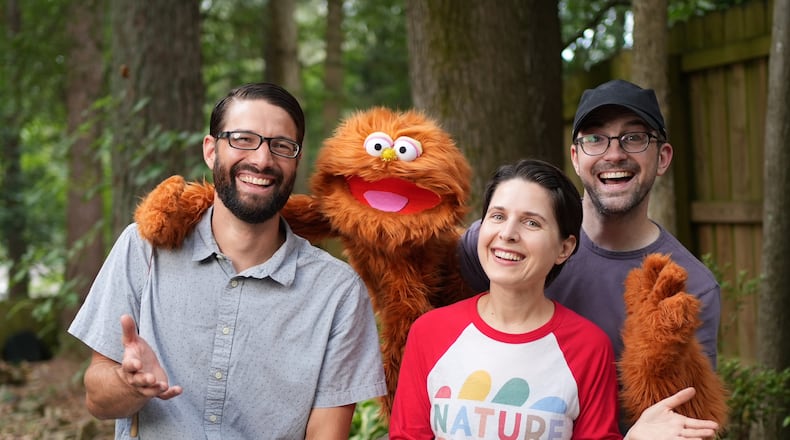Biologist Michael Martin starts a new semester Wednesday teaching cell biology and genetics to Emory at Oxford students. On this humid August morning, Martin’s teaching a boisterous orange furry puppet to take deep breaths in a bee pollinator garden in Decatur.
This summer, Dr. Martin became Mr. Michael, genial host of a series of beguiling nature videos aimed at preschoolers. A father of two young children, Martin impressed Decatur neighbor Elise Potts with his ability to entrance her young son with an examination of leaves in the yard.
A writer of social and emotional learning curriculum, Potts saw nature and natural systems as an ideal way to help children understand interconnectedness. She enjoined Martin to become host for the newfound “Nature Time” series videos. Her husband, engineer and cinematographer Alan Melling, serves as videographer and puppeteer.
At this day’s filming, Melling likely regrets his multiple titles. He’s crouched and compressed behind a stand of flowers manipulating the star of the show, a puppet he designed and sewed named Garbanzo. “You can learn to do anything on YouTube,” he says.
Mr. Michael is trying to show Garbanzo a relaxing stretch that requires the puppet to reach two arms in the air. That feat brings Potts out from behind the camera to assist, leading to a Twister game to maintain her balance and raise the puppet’s arms on cue without being seen.
The trio is on its sixth attempt to nail the complicated shot and manages to do so, despite noise delays as trucks rumble by the city of Decatur’s Willow Lane Pollinator Habitat off North Decatur Road. The film equipment and puppet attract neighborhood residents walking dogs and pushing baby carriages. The kids receive waves from Garbanzo.
Credit: Contributed
Credit: Contributed
In January, Martin, Potts and Melling began to write and record the first four videos in the series, working around full-time jobs and parenting duties. Their kids have helped out on occasion. One-year-old Max Potts doubled as Garbanzo for close-ups of furry legs running in yellow rain boots. Martin’s 7-year-old son Jackson helped with a session on creating a compost jar.
Potts is now working full time on the series, spurred by the initial reception to the “Nature Time” episodes, which made their debut on YouTube in mid-July. In three weeks, the episode “Garbanzo Learns About Composting” drew 44,000 views.
Though Martin is fairly new at video narration, he’s good at it, partly because his approach is not that of a showman, but a guide.
“Instead of amping kids up to run around, I want to slow them down, to look at something and employ some curiosity on their own,” he said. “So, maybe the next time they are outside, they will turn over a rock to see how many worms they can count or see.”
“There is not a whole lot of wild out there for kids anymore,” said Martin. The videos suggest activities — watching squirrels and bees — that can be done in backyards.
For years, Potts and Melling had mulled over a project around kids that combined her skills as a writer and learning designer and his as a cinematographer. Both regarded “Mister Rogers’ Neighborhood” and the tranquility of host Fred Rogers as their north star.
In Martin, they found their own Mr. Rogers and a fellow believer that children thrive in nature.
“Today’s children’s shows have quick cuts to here and there,” said Potts. “For really young kids, that is not good for their attention span. That was something Mr. Rogers focused on — being slow with one perspective and not a lot of fast cuts.”
Melling had worked on nature programs that presented nature as spectacle with big cats and exotic vistas. Filming animals in the wild taught him to “bring a stillness and calm to my work to be effective,” he said. That lesson undergirds the “Nature Time” approach.
The goal of “Nature Time” is to celebrate the nature within reach and nurture children’s inherent curiosity. “Even though we are on YouTube and kids have to engage with a screen, our hope is that they watch and then go outside,” said Potts.
Potts, Melling and Martin realize they are competing with the gizmos, glitter and glamour of Disney and Nickelodeon. As parents, they understand the appeal, but believe a slower pace allows room for kids to grow and think.
“To take care, you have to pay attention, you have to slow down and look around,” said Melling. “Contemporary children’s media is busy so it can entertain kids and hold them down. We want to give them space and time to develop their own knowledge and skills, to be little scientists. You can’t shout at a garden, ‘Grow!’ You have to give it what it needs.”
About the Author
The Latest
Featured




